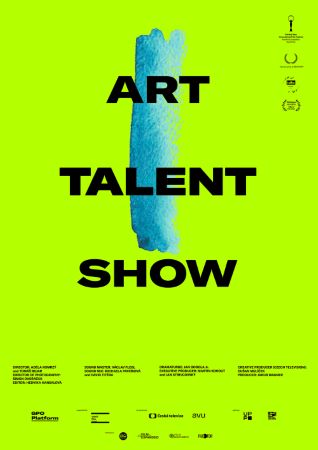
Art Talent Show 2022
Distributed by Film Movement
Produced by Jakub Wagner
Directed by Adela Komrzy and Tomas Bojar
Streaming, 102 mins
College
Art; Education; Teachers
Date Entered: 05/10/2023
Reviewed by Steve Brantley, Head of Research, Engagement, and Scholarship, Professor of Library Services, Eastern Illinois UniversityCan we predict a great artist by their youthful works? How can art professors meaningfully evaluate young artists for their potential future contribution to the art world? The documentary Art Talent Show investigates these questions by filming the admissions exams at the prestigious Academy of Fine Arts in Prague. Each year the academy holds admissions exams for more than 300 young applicants who desire one of just a few spots in the famous and historic school. Art Talent Show provides an insider’s look at the faculty’s process in determining who among them will pass and enter the next cohort of students. Given the Academy’s respected position, students who attend can be expected to influence the direction of contemporary art in years to come.
The directors, Adela Komrzy and Tomas Bojar, adopt a cinema verité style in filming the exams. The camera is always still and shoots from one end of the room, somewhat removed from the action, but capturing much of the room and framing the participants. The film’s subjects are most frequently the faculty from the Graphic Design/Printmaking studio (Vladimir Kokolia, Eva Czervena), the Painting studio (Petr Dub and Marek Meduna), and the New Media studio (Katerina Olivova, Darina Alster). We do not often hear from the students other than their attempts to answer the professor’s questions. Neither do we see much of the student’s visual work, since, like the exams themselves, Art Talent Show is about the process of selection rather than an exhibition of new artworks. We as viewers are given very little information with which to contextualize the film participants. We must assume that the students being examined are also finalists, or at least close to success, since there are fewer than a dozen that we see more than once. In addition to the faculty and students, the Academy’s physical structures play a role in this film, in part because of the Academy’s size, age, and the sheer bulk of the walls, windows and doorways. The camera’s stillness gives us the sense that we are part of the structure as well; silent, motionless, invisible and observant, as these crucial moments in the young artists’ lives play out before us.
Art Talent Show reflects care for its subjects, while also making lighthearted fun of the students. The faculty work hard to make discerning critiques of the students even when the students’ limited experience is apparent. They try to find a unique point of view and depth in the immature work of these high school graduate artists, but they also find humor in the adolescent preoccupations of the students. The faculty take the students seriously but are able to see the absurdity in trying to evaluate some of the work done under the duress of examination time constraints and pressure. The students’ conversations with the professors can become excruciatingly awkward. We can cut the tension with a knife as we watch these young students struggle (and fail) to articulate meaningful answers to the incisive critique the artist-professors require of them.
But the drama of Art Talent Show extends beyond the drama between the students and their professors. At times the filmmakers point their lens at art world outsiders. We meet two middle-aged women who are employed at the Academy as door guards, buzzing visitors and academy personnel in and out of the building. These women casually discuss transphobic attitudes about a student. Other academy personnel (not identified as faculty) comment on the students’ exam work saying, “I want to punch someone in the face when I look at this shit.” These scenes of employees performing their day-to-day responsibilities remind us that art exists in the world. While art has deep intellectual and aesthetic contexts to be pondered by the academy personnel, attitudes existing outside the art world that discount the value of artistic practice are never far away.
Ultimately, Art Talent Show is sympathetic to its subjects. Both faculty and students are treated with dignity, despite the mild fun being poked at them by the filmmakers. We see tender moments between trusted colleagues, and the faculty’s intentions are depicted sympathetically as they tell the applicants to be proud of their accomplishments and talent. The faculty remind students that they must make difficult decisions about admission, even though all the students are talented. Painting professor, Marek Meduna, admits that he himself applied to the academy five times before he was admitted.
We don’t ever find out who is admitted. As the professors say, this process is about relationship building and learning about one another. The exams are a microcosm of the relationships that the artists will build with one another over the course of their education. This film has value for art schools and film schools, but Art Talent Show might also be informative for courses studying human development. Recommended.
Awards:Proxima Grand Prize, Karlovy Vary Int'l Film Festival; FIPRESCI Prize, Karlovy Vary Int'l Film Festival; Official Selection, International Documentary Film Festival, Amsterdam
Published and licensed under the Creative Commons Attribution 4.0 license. Anyone can use these reviews, so long as they comply with the terms of the license.